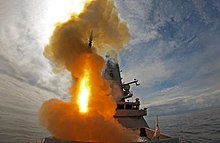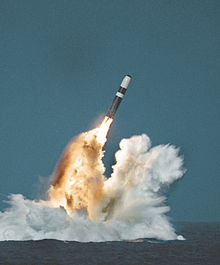Active Royal Navy weapon systems
 |
| His Majesty's Naval Service of the British Armed Forces |
|---|
| Components |
|
| History and future |
| Ships |
| Personnel |
|
| Auxiliary services |
This is a list of Active Royal Navy weapon systems.
Guns
The 4.5-inch (114 mm) Mark 8 gun can be found on all the
The main purpose of the gun is naval gunfire support – artillery bombardment of shore targets. In this role the gun is capable of firing the equivalent of a six-gun shore battery. It can still be used as an anti-ship weapon.[1]
The 30 mm DS-30B Mk 1 and DS30M Mark 2 are 30-millimetre (1.2 in) automated naval gun systems designed to defend ships from fast inshore attack craft armed with short-range weaponry. The DS30M Mark 2 system consists of a
Oerlikon 20 mm cannon
The Oerlikon 20 mm (0.79 in) cannon can be found on the
Browning .50-calibre (12.7 mm) heavy machine gun
The Browning .50-calibre heavy machine gun can be found fitted to ships, the first of which was HMS Atherstone in 2014,[5] and in 2021 it was reported that HMS Lancaster had also been fitted with them.[6]
7.62 mm miniguns
All Royal Navy ships carried miniguns for close in defence.[7][8] But the system was scheduled to be retired from service in 2023 and replaced with Browning .50 caliber heavy machine guns.[9]
7.62 mm General Purpose Machine Gun (GPMG)
GPMGs are used for close in defence.[7][8]
Close-in weapon systems
Phalanx 20 mm
The Phalanx
Phalanx is now the only CIWS fitted to Royal Navy ships following the decommissioning of HMS Invincible, HMS Illustrious and the Type 22 frigates which were equipped with Goalkeeper. The last active Goalkeeper system was removed from HMS Bulwark when she entered extended readiness in 2016.
Torpedoes
Spearfish torpedo
The Spearfish torpedo is the Royal Navy's heavyweight torpedo, weighing nearly 2 metric tons (2.0 long tons; 2.2 short tons), which is carried by both the attack submarines and ballistic missile submarines. It has a range of more than 30 mi (48 km) with a speed in excess of 92 miles per hour (148 km/h) and can be used either against other submarines or ships of any size. It carries a 300 kg (660 lb) explosive charge and is guided either by its in-built sonar or via a copper-cadmium wire.[11]
The Spearfish is undergoing a major upgrade program which will provide sophisticated advances in its homing, warheads, tactical and fueling systems, as well an upgraded guidance link.[12]
Sting Ray torpedo
The Sting Ray torpedo is the Royal Navy's lightweight torpedo which is designed to be carried by the
Depth charges
The Mk11 Depth Charge is a depth charge used by Lynx Wildcat or Merlin Mk2 helicopters to attack enemy submarines.[14]
Mine disposal system
Seafox
The Seafox Mine Disposal System is an
Surface-to-air missiles
Sea Ceptor
The Sea Ceptor missile is currently being integrated [when?] into the Type 23 frigates, as a replacement to the Sea Wolf missile. It has a maximum range over 25 kilometres (16 mi) and can reach Mach 3. The manufacturer states it has a "wide target set", including the capability to engage small naval vessels, which would give the missile a limited surface-to-surface role. A Royal Navy officer of the Type 23 frigate HMS Westminster stated: "Westminster managed to explore the real potential of the system during her training and to say it is a real game changer is an understatement. Unlike its predecessor, the system is capable of defending ships other than Westminster herself. Whether it's engaging multiple air threats or fast incoming attack craft, Sea Ceptor represents a massive capability upgrade for the Type 23 frigate."[15]
Sea Viper

The Sea Viper is the main weapon of the Type 45 destroyers. As part of PAAMS, it can defend an entire naval task group against aerial threats up to 70 mi (110 km) away.
Internationally, the Sea Viper system is known as
Anti-ship missiles
In November 2022, UK Secretary of State for Defence, Ben Wallace, confirmed that Norway's Naval Strike Missile would be purchased to equip a total of eleven of the Royal Navy's Type 23 frigates and Type 45 destroyers on an interim basis.[17][18] Beginning in late 2023, the Naval Strike Missile (NSM) began being fit to a total of 11 Type 23 frigates and Type 45 destroyers in a 2×4 canister configuration to replace the Harpoon Block 1C anti-ship missile, which was formally retired at the end of 2023.[19] The missile also has the capability to attack land targets.[20]
The permanent replacement for Harpoon will be the
Martlet
The Martlet is a lightweight air-to-surface and surface-to-surface missile under development by Thales Air Defence for the United Kingdom. As of 2021, Martlet entered initial service on the Fleet Air Arm's AgustaWestland AW159 Wildcat in the air-to-surface mode with up to twenty Martlet missiles envisaged for deployment on a single Wildcat helicopter. The missile is intended to counter light fast attack boats.[26] Full operating capability is anticipated in 2025.[27]
The Martlet has also been tested in the surface-to-surface mode on the Type 23 frigate, using a launcher mounted on the side of the 30 mm cannon, as a relatively inexpensive missile to use against small craft and unmanned aerial vehicles.
Sea Venom
The Sea Venom is a helicopter-launched lightweight anti-ship missile developed by MBDA to replace the Sea Skua. Sea Venom missiles were reported deployed with Royal Navy Wildcat helicopters operating as part of the Royal Navy's carrier strike group in 2021.[28] The missile weighs 110 kg (240 lb) and has a warhead of 30 kg (66 lb). However, operating challenges were reported in 2023 as "ongoing" and full operating capability for Sea Venom was delayed until 2026.[29][30] It is optimized to attack fast inshore attack craft (FIAC), however it can also damage targets up to corvette size.[31]
Land attack missiles


Tomahawk missile
The Tomahawk missile, also known as TLAM (Tomahawk Land Attack Cruise Missile), allows the Navy's submarines to strike at targets on land accurately. The missile has been in use with the Royal Navy since the late 1990s and has been used in the
The Tomahawk IV is the latest version of the missile. It has a longer range than its predecessors and can be directed at a new target in-flight, and can also beam back images of the battlefield. In British service it is fitted to all Trafalgar and Astute-class submarines.[32] It is currently planned to be[when?] phased out of service in the United States Navy, with no more weapons to be produced after 2015, meaning that it may no longer be an option for the Royal Navy from around the end of the decade.[33] The UK last bought 65 Tomahawk Land Attack Missiles in July 2014.[34]
Trident II D5 ballistic missile
The Trident nuclear missile is
See also
- List of active Royal Navy ships
- List of Royal Navy equipment
References
- ^ "4.5IN MK8 GUN (archive)". royalnavy.mod.uk. Archived from the original on 10 April 2014. Retrieved 19 February 2021.
{{cite web}}: CS1 maint: bot: original URL status unknown (link) - ^ "Supporting the fleet's gun system" (PDF). Desider. July 2017. p. 36. Retrieved 19 February 2021.
- ^ "Close-in defence for the Royal Navy's aircraft carriers". navylookout.com. 28 April 2021. Retrieved 30 April 2021.
- ^ "Atherstone Increasing the Calibre of MCM". royalnavy.mod.uk. Ministry of Defence. November 25, 2014. Retrieved 10 August 2014.
- ^ "Lancaster Lays Down the Lead Testing Extra Firepower". Royal Navy. February 9, 2021. Retrieved March 12, 2021.
- ^ a b Royal Navy Gunnery (archive), royalnavy.mod.uk, Retrieved 11 June 2014
- ^ a b "HMS Daring's Warfare Department". Royal Navy website. Archived from the original on 2010-06-16. Retrieved 2010-06-08.
- ^ "In focus: the 50 cal heavy machine gun in Royal Navy service". Navy Lookout. 5 May 2023. Retrieved 5 May 2023.
- ^ "Phalanx (archive)". royalnavy.mod.uk. Archived from the original on 10 April 2014. Retrieved 19 February 2021.
{{cite web}}: CS1 maint: bot: original URL status unknown (link) - ^ "Spearfish Torpedo (archive)". royalnavy.mod.uk. Archived from the original on 10 April 2014. Retrieved 19 February 2021.
{{cite web}}: CS1 maint: bot: original URL status unknown (link) - ^ BAE Systems Spearfish torpedo, baesystems.com Archived 2014-02-21 at the Wayback Machine
- ^ "Sting Ray torpedo (archive)". royalnavy.mod.uk. Archived from the original on 2012-05-24. Retrieved 19 February 2021.
- ^ Fallon, Michael (9 October 2014). "Type 26 Global Combat Ship" (PDF). parliament.uk. Retrieved 12 March 2019.
- ^ "Missile success for HMS Westminster as second ship to fire new Sea Ceptor". www.royalnavy.mod.uk. Retrieved 2018-03-21.
- ^ "Sea Viper (archive)". royalnavy.mod.uk. Archived from the original on 2012-05-24. Retrieved 19 February 2021.
- ^ "Royal Navy to buy the Naval Strike Missile". Navy Lookout. 23 November 2022. Retrieved 23 November 2022.
- ^ "Royal Navy ships to be fitted with advanced new missile system". gov.uk. 23 November 2022. Retrieved 23 November 2022.
- ^ Scott, Richard (19 December 2023). "First NSM fit on RN Type 23 frigate". Janes. Retrieved 23 April 2024.
- ^ "Norges ukjente supervåpen: Marinefartøyene har kryssermissiler". www.vg.no. 30 May 2016.
- ^ "UK AND FRANCE CONFIRM FC/ASW CONCEPTION PHASE STARTING IN MARCH 2017". MBDA. 16 December 2016. Retrieved August 5, 2022.
- ^ "Royal Navy's Type 26 Frigates to be equipped with cruise missiles by 2028 | Navy Lookout". www.navylookout.com. 9 July 2021. Retrieved August 5, 2022.
- ^ Cabirol, Michel (4 October 2021). "Sous-marins australiens : le programme franco-britannique de missiles de croisière en suspens". La Tribune (in French). Retrieved August 5, 2022.
- ^ GroizeIeau, Vincent (1 October 2021). "Missiles : le programme franco-britannique FMAN/FMC en suspens". Mer et Marine (in French). Retrieved August 5, 2022.
- ^ "Royal Navy rows back on plans to acquire new anti-ship missiles before 2030s | Navy Lookout". Archived from the original on 4 November 2021. Retrieved August 5, 2022.
- ^ "Watch a Royal Navy Wildcat Helicopter Fire Its First Operational Martlet Missile". 22 October 2021.
- ^ Allison, George (23 July 2023). "Martlet achieves progress in operating capabilities". UK Defence Journal.
- ^ "RN Wildcats field new anti-surface guided weapons for CSG21".
- ^ "Royal Navy's Sea Venom light anti-ship missile full operating capability delayed until 2026". Navy Lookout. 21 June 2023.
- ^ "Light Naval Strike: MBDA's Sea Venom / ANL Missile". Defense Industry Daily. 19 December 2018.
- ^ "Tomahawk Cruise Missile (archive)". royalnavy.mod.uk. Archived from the original on 10 April 2014. Retrieved 19 February 2021.
{{cite web}}: CS1 maint: bot: original URL status unknown (link) - ^ "Tomahawk Cancellation an Error of Defense Strategy and Alliance Policy". heritage.org. 2 April 2014. Retrieved 19 February 2021.
- ^ "United Kingdom - Tomahawk Block IV Torpedo Launched Land-Attack Missiles". dsca.mil. 1 July 2014. Retrieved 19 February 2021.
- ^ "Trident D5 Ballistic Missile (archive)". royalnavy.mod.uk. Archived from the original on 10 April 2014. Retrieved 19 February 2021.
{{cite web}}: CS1 maint: bot: original URL status unknown (link)
External links
- Royal Navy (royalnavy.mod.uk)
- Royal Navy — The Equipment — Ships (royalnavy.mod.uk)
